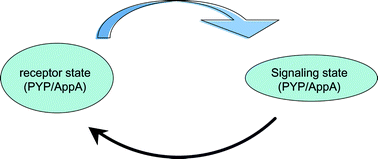To properly respond to changes in fluency conditions, Nature has developed a variety of photosensors that modulate gene expression, enzyme activity and/or motility. Dedicated types have evolved, which can be classified in six families: rhodopsins, phytochromes, xanthopsins, cryptochromes, phototropins and BLUF-proteins. The photochemistry of the first three families is based on cis/trans isomerization of an ethylene bond. Surprisingly, the latter three all use flavin as their chromophore, but each with very different photochemistry. In this contribution we will discuss the molecular basis of signal generation in a xanthopsin (Photoactive Yellow Protein (PYP) from Halorhodospira halophila), a photoreceptor for negative phototaxis, and in a BLUF protein (AppA from Rhodobacter sphaeroides), a transcriptional anti-repressor. PYP is activated through trans/cis isomerization of the 7,8-vinyl bond of its 4-hydroxycinnamic acid chromophore. This initiates a photocycle with multiple intermediates, like pB, which is formed after intramolecular proton transfer. The negative charge thus formed in the interior of the protein triggers formation of a partially unfolded signaling state. For AppA much less is known about the underlying photochemistry. Available evidence suggests that it is based on a light-induced change in the hydrogen-bonding of its flavin chromophore and/or a change in hydrophobic stacking between the flavin and/or nearby aromatic amino acids like Y21. A signaling state is formed within microseconds, which recovers with a rate of ∼10−3 s−1. The change in conformation between receptor- and signaling-state in AppA, however, appear to be minute as compared to those in PYP. Here we review the underlying chemistry in the various steps of the photocycle of these two photoreceptor proteins and provide new data on their mechanism and function.


 Please wait while we load your content...
Please wait while we load your content...